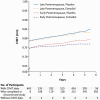Menopausal Hormone Therapy and Cardiovascular Disease: The Role of Formulation, Dose, and Route of Delivery
- PMID: 33506261
- PMCID: PMC8063246
- DOI: 10.1210/clinem/dgab042
Menopausal Hormone Therapy and Cardiovascular Disease: The Role of Formulation, Dose, and Route of Delivery
Abstract
Context: This mini-review provides an overview of menopausal hormone therapy (HT) and cardiovascular disease (CVD) risk, with a focus on the role of hormone formulation, dose, and route of delivery.
Methods: This summary is based on authors' knowledge in the field of menopausal HT and supplemented by a PubMed search using the terms "menopause hormone therapy," "transdermal," "estradiol," "conjugated estrogens," "bioidentical," "cardiovascular disease," "lipoproteins," "glucose," "progestogens," "low dose."
Results: Available evidence indicates that oral unopposed estrogens have a favorable effect on lipoprotein levels, glycemia, insulin, and CVD risk; however, the addition of progestogens blunts the lipid-related effects. The progestogen with the smallest attenuating effect is micronized progesterone. Transdermal estrogens have less effect on coagulation, inflammation, and lipids than oral estrogens and observational studies suggest they pose a lower risk of venous thromboembolism and stroke than oral estrogens. Clinical effects of hormones were not consistently dose dependent.
Conclusions: Although HT continues to have an important role in menopause management, it is not recommended for primary or secondary CVD prevention. Different formulations, doses, and routes of delivery of HT have different effects on cardiometabolic markers and risks of clinical CVD events. However, long-term trials evaluating clinical outcomes with transdermal and other alternate HT regimens are limited.
Keywords: cardiovascular disease; estradiol; hormone therapy; menopause; transdermal.
© The Author(s) 2021. Published by Oxford University Press on behalf of the Endocrine Society. All rights reserved. For permissions, please e-mail: journals.permissions@oup.com.
Figures
References
-
- Grodstein F, Stampfer MJ, Manson JE, et al. . Postmenopausal estrogen and progestin use and the risk of cardiovascular disease. N Engl J Med. 1996;335(7):453-461. - PubMed
-
- Hulley S, Grady D, Bush T, et al. . Randomized trial of estrogen plus progestin for secondary prevention of coronary heart disease in postmenopausal women. Heart and Estrogen/progestin Replacement Study (HERS) Research Group. JAMA. 1998;280(7):605-613. - PubMed
-
- Kannel WB, Hjortland MC, McNamara PM, Gordon T. Menopause and risk of cardiovascular disease: the Framingham study. Ann Intern Med. 1976;85(4):447-452. - PubMed
-
- Rossouw JE, Anderson GL, Prentice RL, et al. ; Writing Group for the Women’s Health Initiative Investigators . Risks and benefits of estrogen plus progestin in healthy postmenopausal women: principal results From the Women’s Health Initiative randomized controlled trial. JAMA. 2002;288(3):321-333. - PubMed
Publication types
MeSH terms
Substances
Grants and funding
LinkOut - more resources
Full Text Sources
Other Literature Sources
Medical


